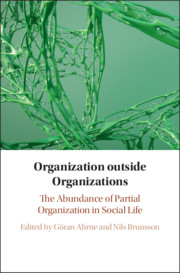Book contents
- Organization outside Organizations
- Organization outside Organizations
- Copyright page
- Contents
- Preface
- Contributors
- Introduction
- Part 1 Rules, Sanctions, Membership
- 2 Standards between Partial and Complete Organization
- 3 Prizes and the Organization of Status
- 4 Membership or Contributorship? Managing the Inclusion of Individuals into Organizations
- Part 2 Organization in and around Markets
- Part 3 Networks and Other Social Relationships
- Part 4 Social Movements and Collective Action
- Part 5 The Partial Organization of Formal Organizations
- Conclusion
- Index
- References
4 - Membership or Contributorship? Managing the Inclusion of Individuals into Organizations
from Part 1 - Rules, Sanctions, Membership
Published online by Cambridge University Press: 11 July 2019
- Organization outside Organizations
- Organization outside Organizations
- Copyright page
- Contents
- Preface
- Contributors
- Introduction
- Part 1 Rules, Sanctions, Membership
- 2 Standards between Partial and Complete Organization
- 3 Prizes and the Organization of Status
- 4 Membership or Contributorship? Managing the Inclusion of Individuals into Organizations
- Part 2 Organization in and around Markets
- Part 3 Networks and Other Social Relationships
- Part 4 Social Movements and Collective Action
- Part 5 The Partial Organization of Formal Organizations
- Conclusion
- Index
- References
Summary
In recent years, researchers have observed the increasing emergence of new forms of organization, in which membership is described as becoming fluid or unclear. Against this backdrop, scholars have proposed to drop membership as a defining criterion for formal organizations and instead to apply the broader concept of ‘contributorship’, which states that there are not only members of an organization, but also contributors who belong partially to the organization, as long as they participate in the organizational processes. I add to this development and combine the concept of contributorship with the decision-based perspective on organizations, which sees decisions as the constitutive elements of organization. Thus, contributorship can be understood as a matter of decision: through their decisions, organizations manage the possibilities for individuals to contribute. I build on two qualitative case studies demonstrating that instead of defining specific members, organizations can decide on spatial, temporal, attributional, resource-related, and/or quantitative-limitational premises for distributing possibilities of contributions.
Keywords
- Type
- Chapter
- Information
- Organization outside OrganizationsThe Abundance of Partial Organization in Social Life, pp. 84 - 112Publisher: Cambridge University PressPrint publication year: 2019
References
- 11
- Cited by



